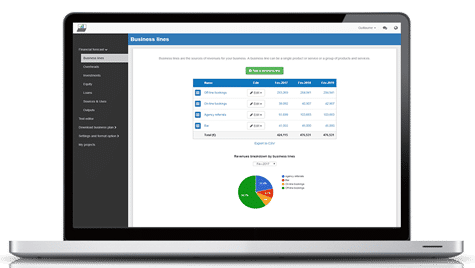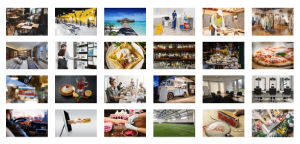How to create a financial forecast for a cosmetic brand?
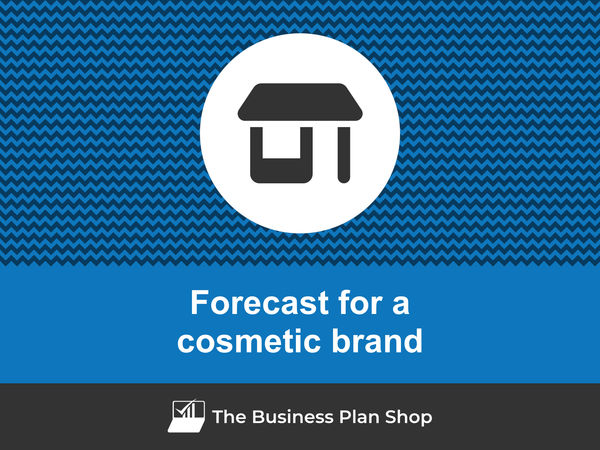
Developing and maintaining an up-to-date financial forecast for your cosmetic brand is key in order to maintain visibility on your business’s future cash flows.
If you feel overwhelmed at the thought of putting together a cosmetic brand financial forecast then don’t worry as this guide is here to help you.
We'll cover everything from: the main objectives of a financial forecast, the data you need to gather before starting, to the tables that compose it, and the tools that will help you create and maintain your forecast efficiently.
Let's get started!
Why create and maintain a financial forecast for a cosmetic brand?
Creating and maintaining an up-to-date financial forecast is the only way to steer the development of your cosmetic brand and ensure that it can be financially viable in the years to come.
A financial plan for a cosmetic brand enables you to look at your business in detail - from income to operating costs and investments - to evaluate its expected profitability and future cash flows.
This gives you the visibility needed to plan future investments and expansion with confidence.
And, when your trading environment gets tougher, having an up to date cosmetic brand forecast enables you to detect potential upcoming financing shortfalls in advance, enabling you to make adjustments or secure financing before you run out of cash.
It’s also important to remember that your cosmetic brand's financial forecast will be essential when looking for financing. You can be 100% certain that banks and investors will ask to see your numbers, so make sure they’re set out accurately and attractively.
Need a convincing business plan?
The Business Plan Shop makes it easy to create a financial forecast to assess the potential profitability of your projects, and write a business plan that’ll wow investors.
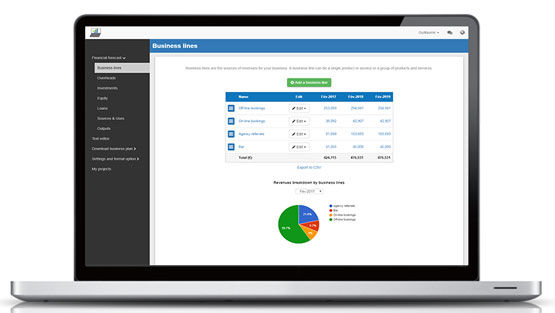
What information is needed to build a cosmetic brand financial forecast?
The quality of your inputs is key when it comes to financial modelling: no matter how good the model is, if your inputs are off, so will the forecast.
If you are building a financial plan to start a cosmetic brand, you will need to have done your market research and have a clear picture of your sales and marketing strategies so that you can project revenues with confidence.
You will also need to have a clear idea of what resources will be required to operate the cosmetic brand on a daily basis, and to have done your research with regard to the equipment needed to launch your venture (see further down this guide).
If you are creating a financial forecast of an existing cosmetic brand, things are usually simpler as you will be able to use your historical accounting data as a budgeting base, and complement that with your team’s view on what lies ahead for the years to come.
Let's now zoom in on what will go in your cosmetic brand's financial forecast.
The sales forecast for a cosmetic brand
From experience, it is usually best to start creating your cosmetic brand financial forecast by your sales forecast.
To create an accurate sales forecast for your cosmetic brand, you will have to rely on the data collected in your market research, or if you're running an existing cosmetic brand, the historical data of the business, to estimate two key variables:
- The average price
- The number of monthly transactions
To get there, you will need to consider the following factors:
- Product Innovation: As a cosmetic brand, you are constantly expected to come up with new and innovative products to stay relevant in the market. The introduction of a unique and high-quality product can increase your average price and attract more monthly transactions.
- Celebrity Endorsements: Partnering with popular celebrities can significantly impact your brand's average price and number of monthly transactions. Customers are more likely to trust and purchase products that are endorsed by their favorite celebrities.
- Economic Conditions: Economic factors such as inflation, changes in disposable income, and consumer confidence can affect your business's average price and monthly transactions. During economic downturns, customers may be more price-sensitive and opt for lower-priced products, while during economic booms, they may be more willing to spend on luxury cosmetics.
- Social Media Influence: With the rise of social media, influencers have become a significant driving force in the cosmetic industry. Collaborating with popular social media influencers can increase your brand's exposure and attract more customers, ultimately increasing your average price and monthly transactions.
- Seasonal Trends: As a cosmetic brand, you may experience fluctuations in your average price and monthly transactions based on seasonal trends. For example, during the holiday season, customers may be more willing to splurge on luxury cosmetic sets, while during summer, they may opt for more affordable products with SPF protection.
Once you have an idea of what your future sales will look like, it will be time to work on your overhead budget. Let’s see what this entails.
Need a convincing business plan?
The Business Plan Shop makes it easy to create a financial forecast to assess the potential profitability of your projects, and write a business plan that’ll wow investors.

The operating expenses for a cosmetic brand
Once you know what level of sales you can expect, you can start budgeting the expenses required to operate your cosmetic brand on a daily basis.
Expenses normally vary based on how much revenue you anticipate (which is why, from experience, it is always better to start your forecast with the topline projection), and where your business is based.
Operating expenses for a cosmetic brand will include some of the following items:
- Staff Costs: These include salaries, wages, and benefits for employees such as sales staff, makeup artists, and marketing specialists.
- Accountancy Fees: You will need to hire an accountant to handle your financial records, taxes, and other financial matters.
- Insurance Costs: As a cosmetic brand, you will need insurance to protect your business from potential liabilities and risks.
- Software Licences: You will need to purchase software licenses for programs such as inventory management, point-of-sale systems, and accounting software.
- Banking Fees: These include fees for maintaining a business bank account, credit card processing fees, and other banking-related expenses.
- Marketing and Advertising Expenses: These include costs for advertising campaigns, influencer partnerships, and social media marketing to promote your brand and products.
- Product Development Costs: This includes expenses for research and development, testing, and sourcing of ingredients for new cosmetic products.
- Packaging and Labeling Costs: These expenses cover the design and production of packaging materials and labels for your products.
- Raw Materials and Supplies: This includes the cost of purchasing ingredients, packaging materials, and other supplies needed for manufacturing your products.
- Rent or Lease: You will need to budget for rent or lease expenses for your office space, manufacturing facility, and retail stores.
- Utilities: These costs include electricity, water, and other utilities needed to run your business.
- Professional Services: This includes fees for legal services, graphic design, and other professional services needed for your business.
- Travel and Entertainment: You may need to travel for business meetings, trade shows, and other events, so budget for expenses such as airfare, accommodations, and meals.
- Training and Development: As a cosmetic brand, it's important to stay updated on industry trends and techniques, so budget for training and development expenses for yourself and your employees.
- Shipping and Logistics: This includes costs for shipping products to customers, retailers, and distributors, as well as warehousing and storage fees.
This list will need to be tailored to the specificities of your cosmetic brand, but should offer a good starting point for your budget.
What investments are needed to start or grow a cosmetic brand?
Your cosmetic brand financial forecast will also need to include the capital expenditures (aka investments in plain English) and initial working capital items required for the creation or development of your business.
For a cosmetic brand, these could include:
- Equipment: This includes items such as makeup brushes, mixing bowls, and packaging machinery. These are essential tools for creating and packaging your cosmetic products.
- Furniture: Furniture is necessary for creating a professional and aesthetically pleasing workspace for your employees. This can include desks, chairs, and display shelves for your products.
- Inventory: As a cosmetic brand, you will need to purchase bulk quantities of ingredients and packaging materials in order to produce your products. This is considered a capital expenditure as it is a long-term asset for your business.
- Software: In today's digital age, it is important to invest in software that can help with tasks such as inventory management, accounting, and customer relationship management.
- Facility Improvements: If you plan on operating out of a physical location, you may need to make improvements or renovations to the space in order to accommodate your business needs. This can include installing shelves, counters, and lighting fixtures.
Again, this list will need to be adjusted according to the size and ambitions of your cosmetic brand.
Need a convincing business plan?
The Business Plan Shop makes it easy to create a financial forecast to assess the potential profitability of your projects, and write a business plan that’ll wow investors.

The financing plan of your cosmetic brand
The next step in the creation of your financial forecast for your cosmetic brand is to think about how you might finance your business.
You will have to assess how much capital will come from shareholders (equity) and how much can be secured through banks.
Bank loans will have to be modelled so that you can separate the interest expenses from the repayments of principal, and include all this data in your forecast.
Issuing share capital and obtaining a bank loan are two of the most common ways that entrepreneurs finance their businesses.
What tables compose the financial plan for a cosmetic brand?
Now let's have a look at the main output tables of your cosmetic brand's financial forecast.
The forecasted profit & loss statement
The profit & loss forecast gives you a clear picture of your business’ expected growth over the first three to five years, and whether it’s likely to be profitable or not.
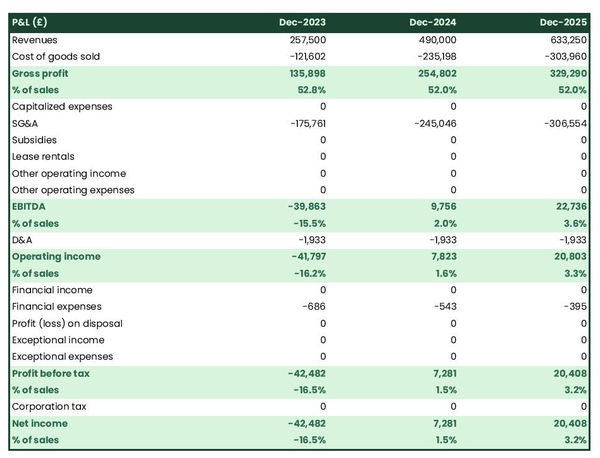
A healthy cosmetic brand's P&L statement should show:
- Sales growing at (minimum) or above (better) inflation
- Stable (minimum) or expanding (better) profit margins
- A healthy level of net profitability
This will of course depend on the stage of your business: numbers for an established cosmetic brand will look different than for a startup.
The projected balance sheet
Your cosmetic brand's projected balance sheet provides a snapshot of your business’s financial position at year-end.
It is composed of three types of elements: assets, liabilities and equity:
- Assets: represent what the business possesses including cash, equipment, and accounts receivable (money owed by clients).
- Liabilities: represent funds advanced to the business by lenders and other creditors. They include accounts payable (money owed to suppliers), taxes payable and loans from banks and financial institutions.
- Equity: is the combination of what has been invested by the business owners and the cumulative profits and losses generated by the business to date (which are called retained earnings). Equity is a proxy for the value of the owner's stake in the business.
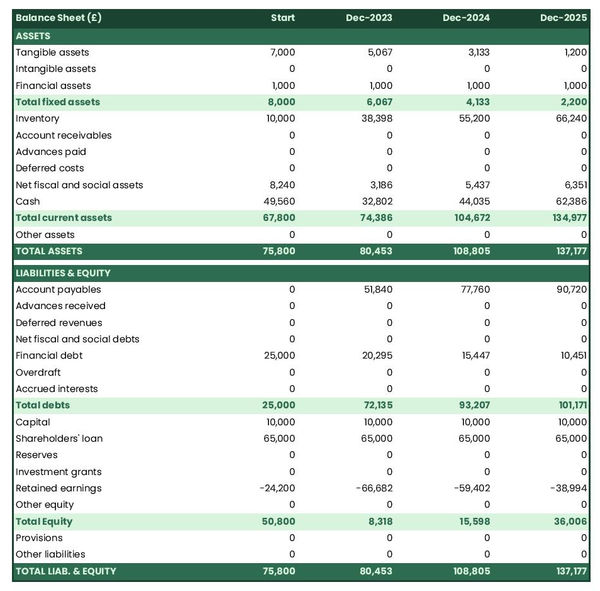
The projected cash flow statement
A projected cash flow statement for a cosmetic brand is used to show how much cash the business is generating or consuming.
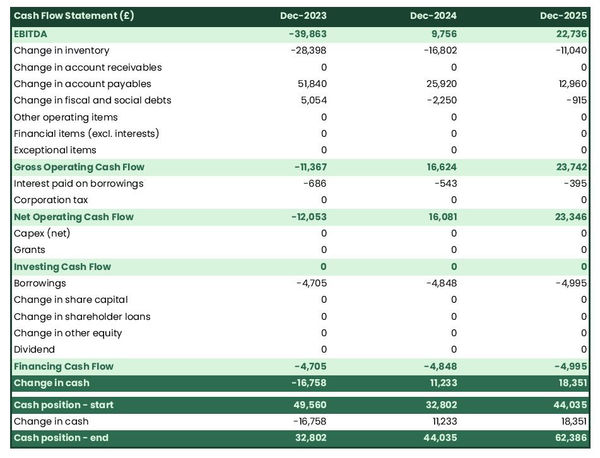
The cash flow forecast is usually organised by nature to show three key metrics:
- The operating cash flow: do the core business activities generate or consume cash?
- The investing cash flow: how much is the business investing in long-term assets (this is usually compared to the level of fixed assets on the balance sheet to assess whether the business is regularly maintaining and renewing its equipment)?
- The financing cash flow: is the business raising new financing or repaying financiers (debt repayment, dividends)?
Cash is king and keeping an eye on future cash flows is imperative for running a successful business. Therefore, you should pay close attention to your cosmetic brand's cash flow forecast.
If you are trying to secure financing, note that it is customary to provide both yearly and monthly cash flow forecasts in a financial plan - so that the reader can analyze seasonal variation and ensure the cosmetic brand is appropriately capitalised.
Need a convincing business plan?
The Business Plan Shop makes it easy to create a financial forecast to assess the potential profitability of your projects, and write a business plan that’ll wow investors.

Which tool should you use to create your cosmetic brand's financial forecast?
Using the right tool or solution will make the creation of your cosmetic brand's financial forecast much easier than it sounds. Let’s explore the main options.
Using online financial forecasting software to build your cosmetic brand's projections
The modern and easiest way is to use an online financial forecasting tool such as the one we offer at The Business Plan Shop.
There are several advantages to using specialised software:
- You can easily create your financial forecast by letting the software take care of the financial calculations for you without errors
- You have access to complete financial forecast templates
- You get a complete financial forecast ready to be sent to your bank or investors
- You can easily track your actual financial performance against your financial forecast, and recalibrate your forecast as the year goes by
- You can create scenarios to stress test your forecast's main assumptions
- You can easily update your forecast as time goes by to maintain visibility on future cash flows
- You have a friendly support team on standby to assist you when you are stuck
- It’s cost-efficient and much cheaper than using an accountant or consultant (see below)
If you are interested in this type of solution, you can try our projection software for free by signing up here.
Calling in a financial consultant or chartered accountant
Outsourcing the creation of your cosmetic brand financial forecast is another possible solution.
This will cost more than using software as you can expect as your price will have to cover the accountant’s time, software cost, and profit margin.
Price can vary greatly based on the complexity of your business. For a small business, from experience, a simple three-year financial forecast (including a balance sheet, income statement, and cash flow statement) will start at around £700 or $1,000.
Bear in mind that this is for forecasts produced at a single point in time, updating or tracking your forecast against actuals will cost extra.
If you decide to outsource your forecasting:
- Make sure the professional has direct experience in your industry and is able to challenge your assumptions constructively.
- Steer away from consultants using sectorial ratios to build their client’s financial forecasts (these projections are worthless for a small business).
Why not use a spreadsheet such as Excel or Google Sheets to build your cosmetic brand's financial forecast?
You and your financial partners need numbers you can trust. Unless you have studied finance or accounting, creating a trustworthy and error-free cosmetic brand financial forecast on a spreadsheet is likely to prove challenging.
Financial modelling is very technical by nature and requires a solid grasp of accounting principles to be done without errors. This means that using spreadsheet software like Excel or Google Sheets to create accurate financial forecasts is out of reach for most business owners.
Creating forecasts in Excel is also inefficient nowadays:
- Software has advanced to the point where forecasting can be done much faster and more accurately than manually on a spreadsheet.
- With artificial intelligence, the software is capable of detecting mistakes and helping decision-making.
Spreadsheets are versatile tools but they are not tailor-made for reporting. Importing your cosmetic brand's accounting data in Excel to track actual vs. forecast is incredibly manual and tedious (and so is keeping forecasts up to date). It is much faster to use dedicated financial planning tools like The Business Plan Shop which are built specially for this.
Need a convincing business plan?
The Business Plan Shop makes it easy to create a financial forecast to assess the potential profitability of your projects, and write a business plan that’ll wow investors.

Use our financial projection templates for inspiration
The Business Plan Shop has dozens of financial forecasting templates available.
Our examples contain both the financial forecast, and a written business plan which presents, in detail, the company, the team, the strategy, and the medium-term objectives.
Whether you are just starting out or already have your own cosmetic brand, looking at our template is always a good way to get ideas on how to model financial items and what to write when creating a business plan to secure funding.
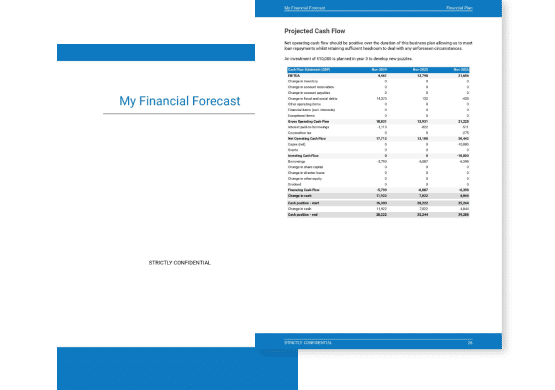
Takeaways
- A financial forecast shows expected growth, profitability, and cash generation metrics for your cosmetic brand.
- Tracking actuals vs. forecast and having an up-to-date financial forecast is key to maintaining visibility on your future cash flows.
- Using financial forecasting software is the modern way of creating and maintaining financial projections.
We hope that this guide helped you gain a clearer perspective on the steps needed to create the financial forecast for a cosmetic brand. Don't hesitate to contact us if you have any questions!
Need a convincing business plan?
The Business Plan Shop makes it easy to create a financial forecast to assess the potential profitability of your projects, and write a business plan that’ll wow investors.

Also on The Business Plan Shop
- Financial forecast example
- Financial forecast template for a business idea
- How to create a turnover forecast for a business?
Know someone who runs a cosmetic brand? Share our business guide with them!

